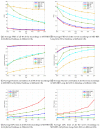A Fast and Robust Non-Sparse Signal Recovery Algorithm for Wearable ECG Telemonitoring Using ADMM-Based Block Sparse Bayesian Learning
- PMID: 29937512
- PMCID: PMC6069014
- DOI: 10.3390/s18072021
A Fast and Robust Non-Sparse Signal Recovery Algorithm for Wearable ECG Telemonitoring Using ADMM-Based Block Sparse Bayesian Learning
Abstract
Wearable telemonitoring of electrocardiogram (ECG) based on wireless body Area networks (WBAN) is a promising approach in next-generation patient-centric telecardiology solutions. In order to guarantee long-term effective operation of monitoring systems, the power consumption of the sensors must be strictly limited. Compressed sensing (CS) is an effective method to alleviate this problem. However, ECG signals in WBAN are usually non-sparse, and most traditional compressed sensing recovery algorithms have difficulty recovering non-sparse signals. In this paper, we proposed a fast and robust non-sparse signal recovery algorithm for wearable ECG telemonitoring. In the proposed algorithm, the alternating direction method of multipliers (ADMM) is used to accelerate the speed of block sparse Bayesian learning (BSBL) framework. We used the famous MIT-BIH Arrhythmia Database, MIT-BIH Long-Term ECG Database and ECG datasets collected in our practical wearable ECG telemonitoring system to verify the performance of the proposed algorithm. The experimental results show that the proposed algorithm can directly recover ECG signals with a satisfactory accuracy in a time domain without a dictionary matrix. Due to acceleration by ADMM, the proposed algorithm has a fast speed, and also it is robust for different ECG datasets. These results suggest that the proposed algorithm is very promising for wearable ECG telemonitoring.
Keywords: alternating direction method of multipliers (ADMM); block sparse Bayesian learning (BSBL); compressed sensing (CS); electrocardiogram (ECG); wireless body area networks (WBAN).
Conflict of interest statement
The authors declare no conflict of interest.
Figures








References
-
- Martin T., Jovanov E., Raskovic D. Issues in wearable computing for medical monitoring applications: A case study of a wearable ECG monitoring device; Proceedings of the Fourth International Symposium on Wearable Computers; Atlanta, GA, USA. 16–17 October 2000; pp. 43–49.
-
- Nemati E., Deen M.J., Mondal T. A wireless wearable ECG sensor for long–term applications. IEEE Commun. Mag. 2012;50 doi: 10.1109/MCOM.2012.6122530. - DOI
-
- Dey N., Ashour A.S., Shi F., Fong S.J., Sherratt R.S. Developing residential wireless sensor networks for ECG healthcare monitoring. IEEE Trans. Consum. Electron. 2017;63:442–449. doi: 10.1109/TCE.2017.015063. - DOI
-
- Sun F.T., Kuo C., Griss M. PEAR: Power efficiency through activity recognition (for ECG–based sensing); Proceedings of the 5th International Conference on Pervasive Computing Technologies for Healthcare (PervasiveHealth); Dublin, Ireland. 23–26 May 2011; pp. 115–122.
MeSH terms
LinkOut - more resources
Full Text Sources
Other Literature Sources

